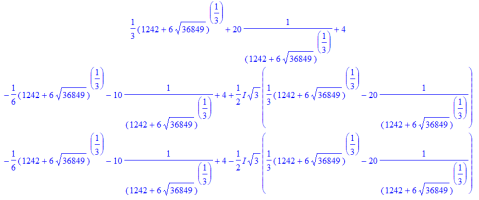You can use a similar approach for [imath]3 \times 3[/imath] matrices.
You subtract all numbers on the diagonal by [imath]\lambda[/imath] and find the values of [imath]\lambda[/imath] such that the determinant of this matrix is 0.
[math]\det \begin{bmatrix}6-\lambda&1&1\\8&7-\lambda&-1\\2&9&-1-\lambda\end{bmatrix} = 0[/math]
To find the determinant of a [imath]3 \times 3[/imath] matrix, you use the following formula:
[math]\det \begin{bmatrix} a_{11} & a_{12} & a_{13} \\ a_{21} & a_{22} & a_{23}\\ a_{31} & a_{32} & a_{33}\end{bmatrix} = a_{11} \det \begin{bmatrix} a_{22} & a_{23}\\a_{32} & a_{33}\end{bmatrix} - a_{12} \det \begin{bmatrix}a_{21} & a_{23} \\ a_{31} & a_{33}\end{bmatrix} + a_{13} \det \begin{bmatrix} a_{21} & a_{22} \\ a_{31} & a_{32}\end{bmatrix}[/math]
This is called
Laplace expansion. You look through a row, and for each element [imath]a_{rc}[/imath] in the [imath]r[/imath]-th row, you cover up the [imath]r[/imath]-th row and the [imath]c[/imath]-th column, and evaluate the determinant. Then multiply that to [imath]a_{rc}(-1)^{r+c}[/imath], and then sum up the results through the row. This works for any row, and the formula I gave for the special case of [imath]3 \times 3[/imath] determinants is the Laplace expansion of first row the determinant.
After using the formula and doing some work, you will find the eigenvalues. Finding eigenvectors is just the same.

